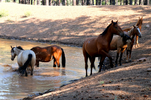Cactus Wren
Campylorhynchus brunneicapillus

Look for them on top of cacti or scrubby bushes, calling loudly in the morning; easier to spot by sound than sight
The cactus wren is the largest wren in North America and a distinctive resident of Arizona’s deserts. Easily recognized by its bold white eyebrows, spotted chest, and loud, raspy calls, this small but charismatic bird is highly visible despite its size. Cactus wrens build nests in cacti, thorny shrubs, or desert trees, providing protection from predators and harsh desert conditions. Officially designated as Arizona’s state bird in 1931, the cactus wren symbolizes resilience and adaptability in extreme environments. It plays an important ecological role by controlling insect populations and dispersing seeds, while its vocalizations and energetic behavior add life and character to desert landscapes.
Bird

Identification & Behavior
Key Features: White eyebrow stripe, brownish body with black spots, long tail with white tips, curved bill
Size: About 7–9 inches long, weighing 1–1.5 ounces
Behavior: Builds large football-shaped nests in cacti or thorny shrubs; pairs may use multiple nests for roosting and raising young
Diet: Primarily insects, but also eats fruits, seeds, and nectar
Activity Pattern: Diurnal (active during the day)
Habitat & Distribution
Found in southern Arizona deserts and desert scrub, including the Sonoran Desert, Tucson Basin, and Superstition Mountains. Present in Coronado and Tonto National Forests.
Elevation Range: Sea level to ~4,000 ft
Seasonal Presence: Year-round
Risks & Management
No danger to humans, but nests are often built in cholla cactus — avoid reaching in!




































